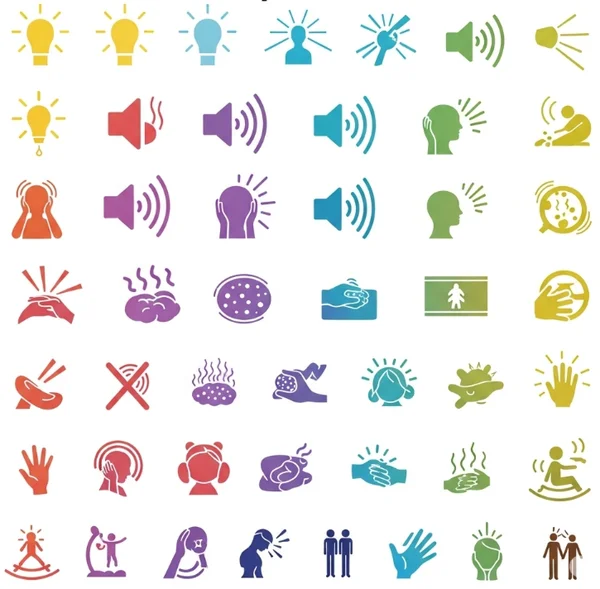RAADS-R Test Domains: A Deep Dive into Its Subscales
June 9, 2025 | By Elara Vance
The RAADS-R test (Ritvo Autism Asperger Diagnostic Scale-Revised) is more than just a single score; it's a comprehensive self-assessment tool that delves into various facets of adult experiences potentially related to autism spectrum disorder (ASD). What are the 4 domains of raads-r? Understanding these core RAADS-R domains, or subscales, can provide a much richer and more nuanced picture of one's traits. This article offers a deep dive into each of these assessment areas, helping you better understand the RAADS-R test available on raads-r.net and what its questions aim to explore.
Understanding the Structure: The Four Key RAADS-R Domains (Subscales)
The RAADS-R test is meticulously structured around four key RAADS-R domains, also referred to as RAADS-R subscales. These domains systematically cover the primary areas where autistic traits often manifest in adults. By breaking down the assessment into these specific areas, the test allows for a more detailed profile of an individual's self-reported experiences.
Why Subscales Matter in Your Overall RAADS-R Test Score
While the total RAADS-R test score gives an overall indication, the subscale scores (if provided by an interpretation or our AI analysis feature) offer valuable insights into which specific areas contribute most significantly to that total. This can help in identifying particular strengths or challenges related to autism traits. For example, someone might score highly overall but have a more pronounced score in the sensory domain compared to the language domain, or vice versa. This detailed questionnaire structure is designed to capture a more complete picture.
A Quick Overview of the Assessment Areas Covered by RAADS-R Subscales
The four core assessment areas covered by the RAADS-R are:
-
Social Relatedness: How an individual experiences and navigates social interactions and relationships.
-
Language: Aspects of verbal and non-verbal communication, including understanding and usage.
-
Sensory-Motor: Responses to sensory stimuli and experiences with motor coordination or repetitive movements.
-
Circumscribed Interests: The nature, intensity, and impact of highly focused interests or adherence to routines. Let's explore each of these RAADS-R domains in more detail for a better understanding raads-r test components.

Social Relatedness in the RAADS-R Test
The RAADS-R social relatedness domain is often a significant area of focus when considering adult autism. This subscale aims to capture the nuances of how adults on the spectrum may experience and engage with the social world differently.
What "Social Relatedness" Encompasses in Adult Autism Assessment
In the context of adult autism assessment, "social relatedness" goes beyond simple shyness or introversion. It explores:
- Social Motivation: The inherent drive or desire to engage with others.
- Reciprocity: The give-and-take in social interactions.
- Understanding Social Cues: Interpreting non-verbal signals like body language, facial expressions, and tone of voice.
- Maintaining Relationships: The challenges and successes in forming and sustaining friendships or romantic partnerships.
- Empathy and Perspective-Taking: While often misunderstood, this explores how one perceives and responds to others' emotions and viewpoints. What does social relatedness mean in raads-r? It means exploring these complex interactive patterns.
Typical RAADS-R Questions Assessing Social Interaction and Empathy
To assess these aspects, the RAADS-R test includes questions that might touch upon (these are conceptual examples, not direct quotes):
- Feeling like an outsider or different from others in social settings.
- Difficulties knowing how to act or what to say in social situations.
- Challenges in understanding if someone is being sarcastic or joking.
- Experiences with being told one has been unintentionally rude or inconsiderate.
- The level of comfort or ease in making and keeping friends. These test questions examples help paint a picture of an individual's social landscape.
Interpreting Your Score in the Social Relatedness Subscale
A higher score in the RAADS-R social relatedness subscale might suggest more significant self-reported difficulties or differences in these areas compared to neurotypical peers. It could point towards challenges in navigating complex social dynamics, which is a common experience for many autistic adults. Interpreting subscale scores here can help identify specific areas for self-awareness or potential support.

The Language Domain of the RAADS-R Test
The RAADS-R language domain explores aspects of verbal and non-verbal communication, which can present uniquely in autistic individuals. What kind of language questions are in raads-r?
Exploring Communication Styles: Literal Interpretation and Pragmatics
This subscale delves into:
- Literal Interpretation: A tendency to understand words and phrases in their most direct, concrete sense, sometimes missing idioms, sarcasm, or implied meanings. This is a key aspect of some autistic communication styles.
- Pragmatics: The social rules of language – knowing what to say, how to say it, when to say it, and understanding the unwritten rules of conversation flow (e.g., turn-taking, topic maintenance).
- Expressive Language: How one uses language to convey thoughts and feelings.
- Receptive Language: How one comprehends spoken or written language.
Sample Questions Related to Verbal and Non-Verbal Language Use
Conceptual examples of RAADS-R test questions in the language domain might include:
- Often taking things too literally.
- Difficulty understanding implied meanings or "reading between the lines."
- Using unusual words or phrases, or speaking in a very formal or pedantic way.
- Challenges with small talk or chit-chat.
- Difficulties understanding or using non-verbal cues like eye contact or gestures effectively during conversation.
Understanding Your Language Subscale Score on the RAADS-R
A higher score on the RAADS-R language subscale may indicate more pronounced differences in these areas of communication. This doesn't necessarily mean a lack of language ability, but rather a different way of processing and using language, which can sometimes lead to misunderstandings in a predominantly neurotypical communication environment.

Sensory-Motor Issues as Measured by the RAADS-R
The RAADS-R sensory motor domain is crucial as sensory experiences and motor patterns are often distinct in autism. How does raads-r assess sensory issues?
Sensory Processing Differences: Hyper- and Hypo-Sensitivities
This part of the RAADS-R test explores:
- Hyper-sensitivities: Being overly sensitive to sensory input like bright lights, loud or specific sounds, certain textures (in food or clothing), smells, or touch. This can lead to sensory overload.
- Hypo-sensitivities: Being under-responsive to sensory input, perhaps seeking out strong sensations, having a high pain threshold, or not noticing certain stimuli.
- Unusual Sensory Interests: A strong fascination or aversion to specific sensory experiences. Understanding these sensory processing differences is vital for adult autism self-assessment.
RAADS-R Questions on Motor Coordination and Repetitive Behaviors (Stimming)
The "motor" aspect of this RAADS-R subscale may touch upon:
- Motor Coordination: Experiences with clumsiness or difficulties with fine or gross motor skills.
- Repetitive Behaviors/Movements (Stimming): Engaging in repetitive actions like rocking, hand-flapping, pacing, or fidgeting, often as a way to self-regulate, manage anxiety, or express excitement. These behavioral patterns are common.
What Your Sensory-Motor Subscale Score Might Indicate
A higher score in the RAADS-R sensory motor domain suggests that sensory experiences and/or motor patterns significantly differ from the neurotypical average. This can have a profound impact on daily life, influencing comfort in various environments, clothing choices, food preferences, and coping mechanisms.

Circumscribed Interests within the RAADS-R Framework
The final key RAADS-R domain is RAADS-R circumscribed interests. This explores the intense and often highly focused areas of interest, as well as a preference for routine and predictability common in autism.
Defining Circumscribed Interests: Intense Focus and Specialized Hobbies
What are circumscribed interests in autism? This refers to:
- Intensity of Interest: A level of focus on specific topics or focused hobbies that is often deeper and more consuming than typical interests.
- Narrowness of Interest: Interests may be very specific or unusual.
- Need for Routine/Sameness: A strong preference for predictability, routines, and consistency, and distress when these are disrupted.
- Repetitive Patterns of Behavior: Adherence to specific ways of doing things or repetitive engagement with certain topics/objects. These are important autism traits.
Examples of RAADS-R Questions About Routines and Focused Passions
Conceptual test questions examples in this domain might include:
- Having very strong interests that you can talk about for long periods.
- Feeling distressed by unexpected changes in plans or routines.
- Having a need for things to be organized or done in a very particular way.
- Spending a lot of time on special interests to the exclusion of other activities.
Interpreting the Circumscribed Interests Subscale Score
A higher score on the RAADS-R circumscribed interests subscale suggests a greater tendency towards these patterns of intense focus and preference for predictability. While often stereotyped, these interests can also be a source of great joy, expertise, and comfort for autistic individuals.

How RAADS-R Subscales Contribute to a Holistic Understanding of Autism Traits
Looking at the RAADS-R subscales individually and collectively provides a more holistic understanding than the total score alone. How do raads-r subscales contribute to the total score? Each contributes, but their individual patterns are revealing.
Beyond the Total Score: The Value of Domain-Specific Insights
The total score on the RAADS-R test gives an overall indication, but the domain-specific insights help pinpoint where autistic traits might be most pronounced. This allows for a more personalized understanding of one's neurodivergent profile. For instance, one might have significant sensory sensitivities but relatively fewer challenges in the language domain.
Using Subscale Information for Self-Awareness and Meaningful Discussion
This detailed information from the RAADS-R domains can be invaluable for self-awareness. It can help you articulate your experiences more clearly to yourself and others. If you choose to seek professional advice, discussing your patterns across these assessment areas can lead to a more fruitful and targeted discussion. For an even more tailored look, consider the AI analysis available after your RAADS-R self-assessment on raads-r.net.
Understanding Your RAADS-R Test Profile: Domains and Deeper Insights
The RAADS-R test, through its four distinct RAADS-R domains or RAADS-R subscales, offers a structured and comprehensive way for adults to explore potential autism traits. By understanding what each domain – Social Relatedness, Language, Sensory-Motor, and Circumscribed Interests – measures, you can gain much deeper insights than from a single score alone. This detailed profile can be a powerful tool for self-understanding and for guiding any further steps you might wish to take on your neurodiversity journey.
Have you taken the RAADS-R test? Did focusing on the different assessment areas provide you with a clearer picture? Share your thoughts or questions in the comments below!
Deep Dive into RAADS-R Test Domains and Subscales
-
What are the four main domains assessed by the RAADS-R test?
The four main RAADS-R domains (or subscales) are: 1. Social Relatedness (covering social interaction, empathy, relationships), 2. Language (verbal and non-verbal communication, literalness), 3. Sensory-Motor (sensory sensitivities, motor coordination, repetitive behaviors), and 4. Circumscribed Interests (intense interests, routines, resistance to change).
-
How does the "Social Relatedness" subscale in the RAADS-R differ from general shyness?
While shyness involves social anxiety or hesitancy, the RAADS-R social relatedness subscale explores deeper, often lifelong patterns in understanding and navigating social cues, reciprocity, forming connections, and perspective-taking that are characteristic of autism traits, which may or may not co-exist with shyness.
-
Can a high score in one RAADS-R domain but low in others still indicate autism traits?
Autism presents very differently in each individual. It's possible to have pronounced traits in one or two RAADS-R domains (e.g., very high sensory sensitivities or circumscribed interests) and fewer in others. A comprehensive understanding raads-r test results, ideally with professional input, is needed to interpret such a profile. The overall pattern and impact on daily life are key.
-
Are the RAADS-R subscale scores as important as the total score?
Both the total score and the RAADS-R subscale scores offer valuable information. The total score gives a general indication of the level of self-reported autistic traits. The subscale scores provide a more detailed breakdown, highlighting specific areas of strength or challenge, which can be very useful for interpreting subscale scores for personalized understanding and identifying support needs.
-
Where can I find examples of questions for each RAADS-R domain to better understand them?
While specific copyrighted RAADS-R questions cannot be listed here, this article provides conceptual examples of the types of experiences each domain explores. Taking the full RAADS-R test on raads-r.net will allow you to see all the questions within their respective (though not explicitly labeled during the test) domains.